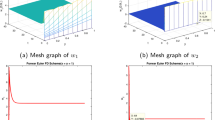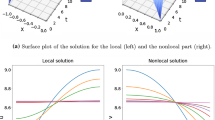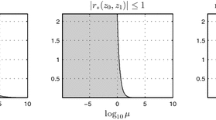Abstract
Operator splitting is a numerical method of computing the solution to a differential equation. The splitting method separates the original equation into two parts over a time step, separately computes the solution to each part, and then combines the two separate solutions to form a solution to the original equation. A canonical example is splitting of diffusion terms and convection terms in a convection-diffusion partial differential equation. Related applications of splitting for reaction-diffusion partial differential equations in chemistry and in biology are emphasized here. The splitting idea generalizes in a natural way to equations with more than two operators. In all cases, the computational advantage is that it is faster to compute the solution of the split terms separately, than to compute the solution directly when they are treated together. However, this comes at the cost of an error introduced by the splitting, so strategies have been devised to control this error. This chapter introduces splitting methods and surveys recent developments in the area. An interesting perspective on absorbing boundary conditions in wave equations comes via Toeplitz-plus-Hankel splitting. One recent development, balanced splitting, deserves and receives special mention: it is a new splitting method that correctly captures steady state behavior.
Access this chapter
Tax calculation will be finalised at checkout
Purchases are for personal use only
Similar content being viewed by others
Notes
- 1.
An exercise in Golub and Van Loan [22] shows that \([\boldsymbol{A},\boldsymbol{B}] =\boldsymbol{ 0}\) if and only if \(e^{h(\boldsymbol{A}+\boldsymbol{B})} = e^{h\boldsymbol{A}}e^{h\boldsymbol{B}}\) for all h.
- 2.
See, for example, Rauch’s notes on Turing instability [48].
- 3.
Here we assume \(\boldsymbol{A}\) and \(\boldsymbol{B}\) are invertible. The non-invertible case is treated by the variation-of-parameters formula [58].
References
Ascher, U., Ruuth, S., Wetton, B.: Implicit-explicit methods for time-dependent partial differential equations. SIAM Journal on Numerical Analysis (1995)
Asmussen, S., Glynn, P.W.: Stochastic Simulation: Algorithms and Analysis. Springer (2007)
Blanes, S., Casas, F., Chartier, P., Murua, A.: Optimized high-order splitting methods for some classes of parabolic equations. Math. Comput. (2012)
Boyd, S., Parikh, N., Chu, E., Peleato, B., Eckstein, J.: Distributed Optimization and Statistical Learning via the Alternating Direction Method of Multipliers. Foundations and Trends in Machine Learning pp. 1–122 (2011)
Butcher, J.: Numerical Methods for Ordinary Differential Equations. Wiley (2003)
Cao, Y., Gillespie, D.T., Petzold, L.R.: The slow-scale stochastic simulation algorithm. J. Chem. Phys. 122, 014,116–1–18 (2005)
Chorin, A.J.: Numerical solution of the Navier-Stokes equations. Math. Comp. pp. 745–762 (1968)
Dahlquist, G.: Convergence and stability in the numerical integration of ordinary differential equations. Math. Scand. pp. 33–53 (1956)
Dahlquist, G.: A special stability problem for linear multistep methods. BIT Numerical Mathematics pp. 27–43 (1963)
Dahlquist, G., Björk, A.: Numerical Methods. Prentice-Hall (1974)
Daubechies, I.: Ten Lectures on Wavelets. SIAM (1992)
Descombes, S.: Convergence of a splitting method of high order for reaction-diffusion systems. Mathematics of Computation 70 (236), 1481–1501 (2001)
Descombes, S., Schatzman, M.: Directions alternées d’ordre élevé en réaction-diffusion. Comptes Rendus de l’Académie des Sciences. Série 1, Mathématique 321 (11), 1521–1524 (1995)
Douglas, J., Rachford, H.H.: On the numerical solution of heat conduction problems in two and three space variables. Trans. Amer. Math. Soc. pp. 421–439 (1956)
E, W., Liu, D., Vanden-Eijnden, E.: Nested stochastic simulation algorithm for chemical kinetic systems with disparate rates. J. Chem. Phys. 123 (19), 194,107 (2005)
Engblom, S.: Strong convergence for split-step methods in stochastic jump kinetics (2014). http://arxiv.org/abs/1412.6292
Engquist, B., Majda, A.: Absorbing boundary conditions for numerical simulation of waves. Proc Natl Acad Sci U S A 74, 765–1766 (1977)
Ferm, L., Lötstedt, P.: Numerical method for coupling the macro and meso scales in stochastic chemical kinetics. BIT Numerical Mathematics 47 (4), 735–762 (2007)
Ferm, L., Lötstedt, P., Hellander, A.: A hierarchy of approximations of the master equation scaled by a size parameter. J. Sci. Comput. 34, 127–151 (2008)
Giles, M.: Multi-level Monte Carlo path simulation. Operations Research 56, 607–617 (2008)
Goldstein, T., Osher, S.: The Split Bregman Method for L1-Regularized Problems. SIAM Journal on Imaging Sciences 2 (2), 323–343 (2009)
Golub, G.H., Van Loan, C.F.: Matrix Computations. Johns Hopkins (1996)
Haberman, R.: Applied Partial Differential Equations. Prentice Hall (2013)
Hairer, E., Lubich, C., Wanner, G.: Geometric numerical integration: Structure-preserving algorithms for ordinary differential equations. Springer (2006)
Hellander, A., Hellander, S., Lötstedt, P.: Coupled mesoscopic and microscopic simulation of stochastic reaction-diffusion processes in mixed dimensions. Multiscale Model. Simul. pp. 585–611 (2012)
Hellander, A., Lawson, M., Drawert, B., Petzold, L.: Local error estimates for adaptive simulation of the reaction-diffusion master equation via operator splitting. J. Comput. Phys (2014)
Higdon, R.: Numerical Absorbing Boundary Conditions for the Wave Equation. Mathematics of Computation 49, 65–90 (1987)
Higham, N.J.: Functions of Matrices. SIAM (2008)
Horn, R., Johnson, C.: Matrix Analysis. Cambridge University Press (2013)
Hundsdorfer, W., Verwer, J.: Numerical Solution of Time-Dependent Advection-Diffusion-Reaction Equations. Springer (2003)
Iserles, A.: A First Course in the Numerical Analysis of Differential Equations. Cambridge University Press (1996)
Jahnke, T., Altintan, D.: Efficient simulation of discrete stochastic reaction systems with a splitting method. BIT 50, 797–822 (2010)
Lax, P.D., Richtmyer, R.D.: Survey of the stability of linear finite difference equations. Comm. Pure Appl. Math pp. 267–293 (1956)
Lee, J., Fornberg, B.: A split step approach for the 3-D Maxwell’s equations. J. Comput. Appl. Math. 158, 485–505 (2003)
Loh, P.R., Oskooi, A.F., Ibanescu, M., Skorobogatiy, M., Johnson, S.G.: Fundamental relation between phase and group velocity, and application to the failure of perfectly matched layers in backward-wave structures. Phys. Rev. E 79, 065,601 (2009). DOI 10.1103/PhysRevE.79.065601. URL http://link.aps.org/doi/10.1103/PhysRevE.79.065601
Lubich, C., Oseledets, I.: A projector-splitting integrator for dynamical low-rank approximation. BIT Numerical Mathematics 54, 171–188 (2014)
MacNamara, S., Burrage, K., Sidje, R.: Application of the Strang Splitting to the chemical master equation for simulating biochemical kinetics. The International Journal of Computational Science 2, 402–421 (2008)
MacNamara, S., Burrage, K., Sidje, R.: Multiscale Modeling of Chemical Kinetics via the Master Equation. SIAM Multiscale Model. & Sim. 6 (4), 1146–1168 (2008)
Maini, P.K., Baker, R.E., Chuong, C.M.: The Turing model comes of molecular age. Science 314, 1397–1398 (2006)
Marchuk, G.I.: Some application of splitting-up methods to the solution of mathematical physics problems. Aplikace Matematiky pp. 103–132 (1968)
Marchuk, G.I.: Splitting and alternating direction methods. In: P. Ciarlet, J. Lions (eds.) Handbook of Numerical Analysis, vol. 1, pp. 197–462. North-Holland, Amsterdam (1990)
McLachlan, R., Reinout, G., Quispel, W.: Splitting methods. Acta Numer. 11, 341–434 (2002)
Moler, C., Van Loan, C.: Nineteen Dubious Ways to Compute the Exponential of a Matrix, 25 Years Later. SIAM Review 45(1), 3–49 (2003)
Murray, J.: Mathematical Biology: An Introduction. New York: Springer (2002)
Ninomiya, S., Victoir, N.: Weak approximation of stochastic differential equations and application to derivative pricing. Applied Mathematical Finance 15 (2008)
Pavliotis, G., Stuart, A.: Multiscale Methods: Averaging and Homogenization. Springer (2008)
Peaceman, D.W., Rachford Jr., H.H.: The numerical solution of parabolic and elliptic differential equations. Journal of the Society for Industrial and Applied Mathematics (1955)
Rauch, J.: The Turing Instability. URL: http://www.math.lsa.umich.edu/~rauch/
Reddy, S.C., Trefethen, L.N.: Pseudospectra of the convection-diffusion operator. SIAM J. Appl. Math (1994)
Ropp, D., Shadid, J.: Stability of operator splitting methods for systems with indefinite operators: Reaction-diffusion systems. Journal of Computational Physics 203, 449–466 (2005)
Saad, Y.: Iterative Methods for Sparse Linear Systems. SIAM, Society for Industrial and Applied Mathematics, Philadelphia (2003)
Schatzman, M.: Toward non commutative numerical analysis: High order integration in time. Journal of Scientific Computing 17, 99–116 (2002)
Speth, R., Green, W., MacNamara, S., Strang, G.: Balanced splitting and rebalanced splitting. SIAM Journal of Numerical Analysis 51 (6), 3084–3105 (2013)
Strang, G.: On the construction and comparison of difference schemes. SIAM J. Numer. Anal. 5 (2), 506–517 (1968)
Strang, G.: Computational Science and Engineering. Wellesley-Cambridge Press (2007)
Strang, G.: Introduction to Linear Algebra. Wellesley-Cambridge Press (2009)
Strang, G.: Essays in Linear Algebra. Wellesley-Cambridge Press (2012)
Strang, G.: Differential Equations and Linear Algebra. Wellesley-Cambridge Press (2014)
Strang, G., MacNamara, S.: Functions of difference matrices are Toeplitz plus Hankel. SIAM Review 56 (3), 525–546 (2014)
Trefethen, L.: Numerical analysis. In: T. Gowers, J. Barrow-Green, I. Leader (eds.) Princeton Companion to Mathematics, pp. 604–615. Princeton University Press (2008)
Trefethen, L., Embree, M.: Spectra and Pseudospectra: The Behavior of Nonnormal Matrices and Operators. Princeton University Press (2005)
Usadi, A., Dawson, C.: 50 years of ADI methods: Celebrating the contributions of Jim Douglas, Don Peaceman, and Henry Rachford. SIAM News 39 (2006)
Wanner, G.: Dahlquist’s classical papers on stability theory. BIT Numerical Mathematics 46, 671–683 (2006)
Widom, H.: Toeplitz matrices. In: I.I. Hirschman (ed.) Studies in Real and Complex Analysis. Prentice-Hall (1965)
Yoshida, H.: Construction of higher order symplectic integrators. Phys. Lett. A. 150, 262–268 (1990)
Author information
Authors and Affiliations
Corresponding author
Editor information
Editors and Affiliations
Rights and permissions
Copyright information
© 2016 Springer International Publishing Switzerland
About this chapter
Cite this chapter
MacNamara, S., Strang, G. (2016). Operator Splitting. In: Glowinski, R., Osher, S., Yin, W. (eds) Splitting Methods in Communication, Imaging, Science, and Engineering. Scientific Computation. Springer, Cham. https://doi.org/10.1007/978-3-319-41589-5_3
Download citation
DOI: https://doi.org/10.1007/978-3-319-41589-5_3
Published:
Publisher Name: Springer, Cham
Print ISBN: 978-3-319-41587-1
Online ISBN: 978-3-319-41589-5
eBook Packages: Mathematics and StatisticsMathematics and Statistics (R0)




